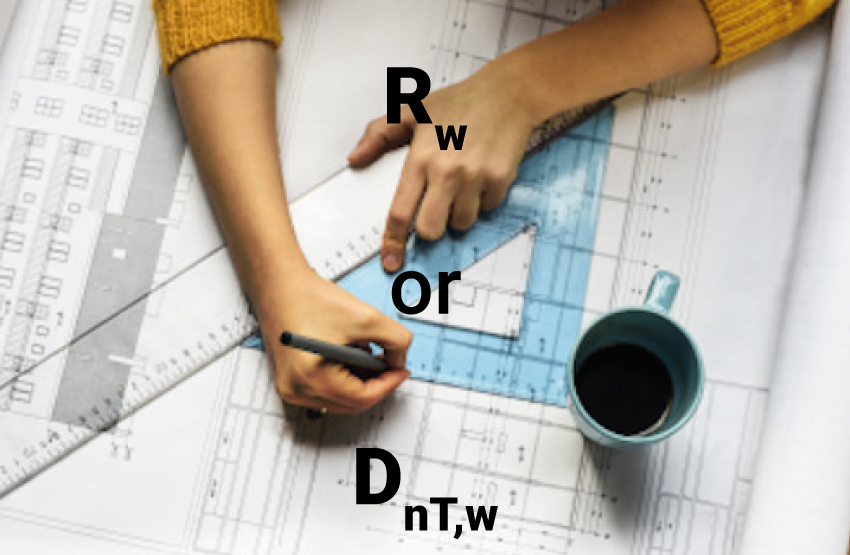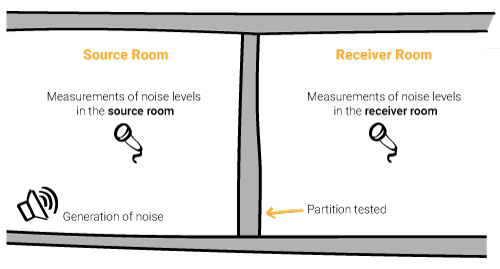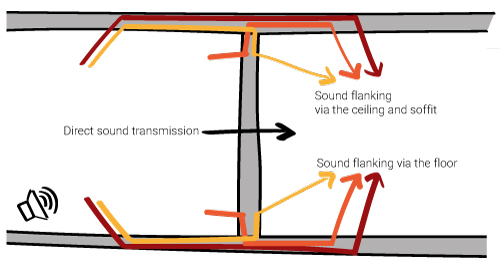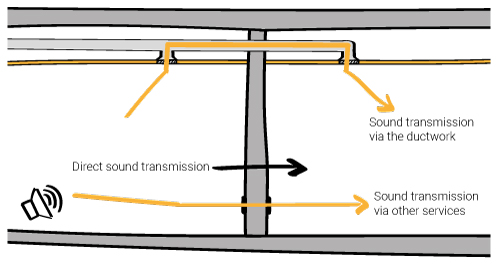
You are probably trying to select dry lining products for your project and can see two different ratings on the acoustic specification (or the mark-ups).
One is Rw, which is a laboratory sound insulation rating. The other is DnT,w , the on-site sound insulation rating.
Note
for ease of reading we will stick to Rw=lab rating and DnT,w= on-site rating. But be aware that the terms can vary depending on the situation including the types of spaces separated by the partition, the type of building and the country.
They both represent the reduction in sound transmission through a building element. In more technical terms, we say they correspond to the airborne sound insulation performance of the element.
This post explains:
- which sound insulation rating to use for your selection
- what both ratings actually mean and what you use them for
- why, on the acoustic specification, the ratings have different values for a single partition type
- why some partitions only have a laboratory rating
- how to remember which one is which without reading this post again
Enjoy the read!
(See at the end the references used to confirm the concepts)

Do you want to be notified when new posts are published?
Why don’t you subscribe to Atelier Crescendo’s newsletter by clicking here?
Which sound insulation rating to use for your selection?
The quick answer is: use the laboratory rating (Rw).
What are the laboratory and on-site sound insulation ratings? and what are they used for?
In practical terms, both ratings represent the difference between the noise levels measured on either side of an element.
The general principles for the measurements are as follows:
- generate sound in one room, the source room.
- measure the sound level in this source room.
- measure the sound in the room that shares the partition studied, the receiver room.

Both airborne sound insulation ratings correspond to different types of testing conditions.
The paragraphs below explain this a little bit more.
Laboratory sound insulation rating
The laboratory rating, Rw, is useful for suppliers or manufacturers. This way, they give us an idea of the performances their products can achieve.
In a lab, you test the products in very specific and standardised conditions:
- The samples tested have a set size and they are connected to specific elements.
- The testing rooms have particular sizes, shapes and acoustic characteristics.
- The performances are measured and calculated in a certain way.
These allow the acoustic consultants to use the laboratory rating as a benchmark for their design. Although they know there is more work to do to achieve what they need.
On-site sound insulation rating
The on-site rating, DnT,w , is given as a requirement in most standards, guidelines and building regulations.
It represents the sound insulation performance you are contracted to achieve once a building is completed.
Therefore, this is the sound insulation performance the acoustic engineer will test during the commissioning of a building.
On-site sound insulation rating
The on-site rating, DnT,w , is given as a requirement in most standards, guidelines and building regulations.
It represents the sound insulation performance you are contracted to achieve once a building is completed.
Therefore, this is the sound insulation performance the acoustic engineer will test during the commissioning of a building.
Ok, but why are the ratings different on the acoustic specification?
As mentioned above, the testing conditions in a lab are very particular.
They are designed in a way to minimise the sound transmissions around the samples.
In technical terms, you call it sound flanking. It happens via:
- the connections
- the services
- the flooring systems/slabs
- the ceiling systems/slabs
- other paths that connect the building elements


Acoustic consultants know that the sound flanking is more important in actual buildings than in laboratories. So they underestimate the lab rating by applying a negative correction to take account of the sound flanking.
This correction is generally around 5-7 dB for drylining partitions. It is less for masonry partitions.
Note
if you are working with “lightweight” partitions that need to achieve ratings with an extension at low frequencies, you might need to use a higher correction. In other words, you need to underestimate even more the laboratory rating.
This is particularly the case for timber constructions.
Be aware that, even if you apply this correction, you are not exempt from spending time designing the junction details between the partitions and the other building elements.
And why do some partitions only have one rating?
Because you either won’t have to or won’t be able to test them.
Examples are:
- partitions with openings, doors, serving hatches or windows/vision panels
- service risers
- lining or boxing systems for services and structural elements
- lift shafts
How to remember which one is which?
Any easy way to remember is to look at the subscripts.
As described above, both ratings are based on the sound level difference measured between a source room and a receiving room separated by the partition studied.
Rw is the rating measured in a laboratory under standardised conditions, i.e. the same for all the measurements. It can be used as a benchmark and the measurements are weighted. Hence the “w” in the subscript (it corresponds to the way it has been calculated but we won’t go into details here).
DnT,w is the rating measured on-site under building conditions, i.e. different for most measurements. So as well as weighting the measurements (“w” in the subscript), you also need to standardise them. Hence the “nT” in the subscript.
Note
Standardising the measurements takes account of the specific sound reverberation conditions in the receiving room. It gives a more subjective performance for a partition depending on how and where it is installed in a building.
So the subscript for the on-site rating is longer than for the laboratory rating, because you need to consider the particular conditions on-site.
